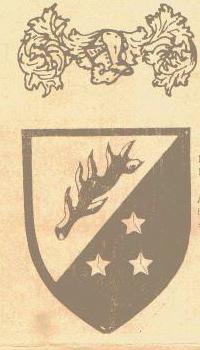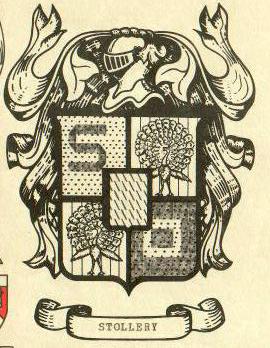
Home Page
Ancestors to 1700s
Ancestors 1703 to the 1840s
From the 1840s Onward
In the 20th Century
Map Page
Generations 15 and 16
Our 'Orphans'
Coats of Arms
Coat of Arms p.2
|
Our Coats of Arms
At present, three are known, and one -- maybe two -- others are "mentioned."
Of the three known coats of arms, which one(s) are true? Unfortunately, that type of research is costly. We feel fortunate to have the discriptions and their artistic representations.
(Note: Later, we hope to be able to 'color' them correctly.)
211 David John Stollery used to say that the Stollery who was in King Richard's entourage was a "staller" or king's taster, therefore "Stallery." The note was sent to 255 Edward Wilfrid by 254 David John Jr.
|
|
Editor's guess for the oldest:
"Armorial Bearings
Stallery
of England
----------------
Ermine a chevron
engrailed gules
|
|
Why oldest?
One word answer: Simplest.
A common backgrond, "engraved gules," divided solely by a chevron.
It is the simplest design of the 'proper' sort; that it's penned "Stallery" on its sketch indicates to your editor that it applies to the mid-1500s when Stollerys WERE Stallerys. BUT -- see below for more information on this aspect.
Source for this, is
"Lincoln's Inn Heraldic Studios,
9 Grreat Turnstile
Lincoln's Inn Fields
London W. C."
and is annotated at the bottom "Messrs. Mussett."
Oh, and note: this one is considerd to be "noble" because the "armet" -- decoration along the top of the shield -- is connected to the shield.
|
|
As to the anecdote: "King Richard" or "King Charles" didn't live or reign at a time appropriate for STALLER to have entered our family line. If a king were served, it would have been Henry VIII, the man of many wives. 1 Thomas STALWORTHY named his three (discovered) sons STOLLAR, which is permissable spelling of the presumed sound of STALLER ... Thomas could have left Henry's retinue because of the pregnancy of his (wife?). Review the dates at hand: the dates DO fit.
Your editor considered all other kings of the period 1253-1700 and only Henry VIII stood out as a "logical target;" avengers of his earlier wives! It'd be quite a scenario, unfettered by any printed record, of course!
|
|
Next in your editor's opinion is one which might have been given to the illegitimate offspring of a high ranking person. Its "armet" is NOT conne ted to the Arms, so we're told this indicates it is NOT noble:
"Per bend sinister: in chief or, a hart's antler in bend sinister sable; in base sable, three mullets or, posed in a demi-orle."
The Sanson Institute of Heraldry, Boston, said its reverence source was the "Armorial Ge'ne'ral by J. B. Rietstap."
There is an inked (possibly reference) "XBS 1574" on the report
|
 |
Mystery Parents? Or just Mystery?
"Bend sinister" means the division is 'left-handed;' upper right to lower left -- which has been casually used to suggest non-legitimate offspring (not able to claim the land, for example) but who ARE allowed to bear "arms."
The separation of the "armet" from the shield, indicating it's not noble, supports the belief the recipient of these arms is "base born." There is only one STOLLERY whose record indicates he is "base born."
Brice Stollery,(59) is "son base born of Margaret Stollery April 28, 1721." Margaret, born in 1688, has a child in the same town she was born in and lived in...so she was apparently NOT afraid of having the 'bastard.' Is this because she was the recognised consort of some noble?
Your editor did notice two births (90 and 91) to a "Sarah Stollery." They are duplicates of a prior entry.
66 William Stollery had a daughter, 92 Esther Moore, christened May 23, 1769 in Stonham Aspal, Suffolk. Esther's birth was noted as "base born."
Although there's no direct knowledge of connection, the parallels DO create interest: who's what? Is this Brice's Coat? If so, there's an implication that one could trace his father...true?
(Well, match the devices from this coat of arms with those known....)
|
|
Newest of the Three?
Before we get to it, why would we think they belong to different eras? Frankly, we started at the simplest of arms: a single "device," the engrailed gules; on a simple background, divided by a single chevron.
The second one chosen is a "base sinester" but with two devices (hart's horn, stars) in only two guises (black horn, gold stars on a black background).
The third "Coat of arms" comes from a different source. |
|
|
"Quartered, 1st, or; the letter "S" sa.;
2nd and 3rd, gu.: a peacock in pride ppr.;
4th, sa.; an orle or.
Charged with a small inner shield vert."
meaning>
Divided into quarters: 1st quarter, gold background, a black initial "S"
2nd (top right as we see it), and
3rd (bottom left) a red background,
a peacock proper tail expanded;
4th quarter, black background; gold inner border.
A small green inner shield placed over all (centered).
|
 |
Your editor is going way out on a limb with this guess -- and, mind you, until YOU are heard from, it's ONLY a guess!
We have a quartered shield with a second shield 'overlaid' in the center. The oldest element is probably the peacock, illustrating perhaps the 'noble' line.
The block "S" in the first quarter of the shield speaks to the S of Stollery. This speaks, to your editor, of being a commercial coat of arms -- or a coat of arms "awarded" for commercial reasons. (Certainly an inspection of the bare information on the previous pages is NOT illustrative!)
PEACOCK is a symbol of vanity, beauty and pride; the incorporation of green is a sign of hope, vitality and (plenty: ie, productive). Again, usually more associated with commercial enterprises than Military. (The first two coats, above, are more in line with more military-oriented types, in your editor's opinion.)
This shield and information came from Halberts, of Bath, Ohio; the historiography was prepared for the editor's father.
One last observation: The "armet" is attached to the top of the shield -- if it is to be believed. Your editor's guessing this one would date to about the 1700s to 1800s, long after the knights wore their armor. (We did have one Freeman of the City of London; 164 John, 1849-1922. This could be connected to him. He was an architect, which is in your editor's thinking less rural than the Coat is. Oh well...?)
|

|
RIGHT OR WRONG: TELL ME PLEASE
mailto: edstollery@yahoo.com |
 |
LATE WORD: SHIELD IS DOUBTFUL
Email about this Coat from a non-family person indicates that HIS family has a similar coat -- only marked with a P in the first block.
Halbert's is normally a trustworthy business place; however two coats of arms, differing only in the initial, in the upper left (as you look at it) quadrant?
Above I remarked this could have been a commercial coat, not a nobility or warrior coat of arms. Its use as true Armorial bearings is low because of the large amount of detail -- rendering it not easy to read on the battlefield. However, it would not be TOO unusual to have two businesses using variations on a single "logo," if we consider the Coat as a business "logo" or colophon. We certainly do NOT know enough about this coat to understand it. |
|
|